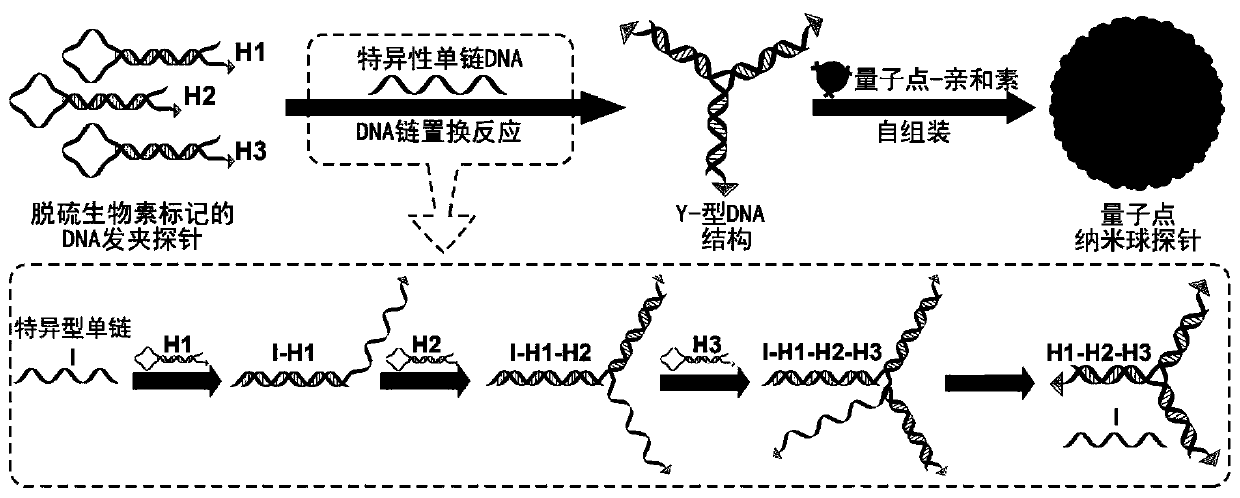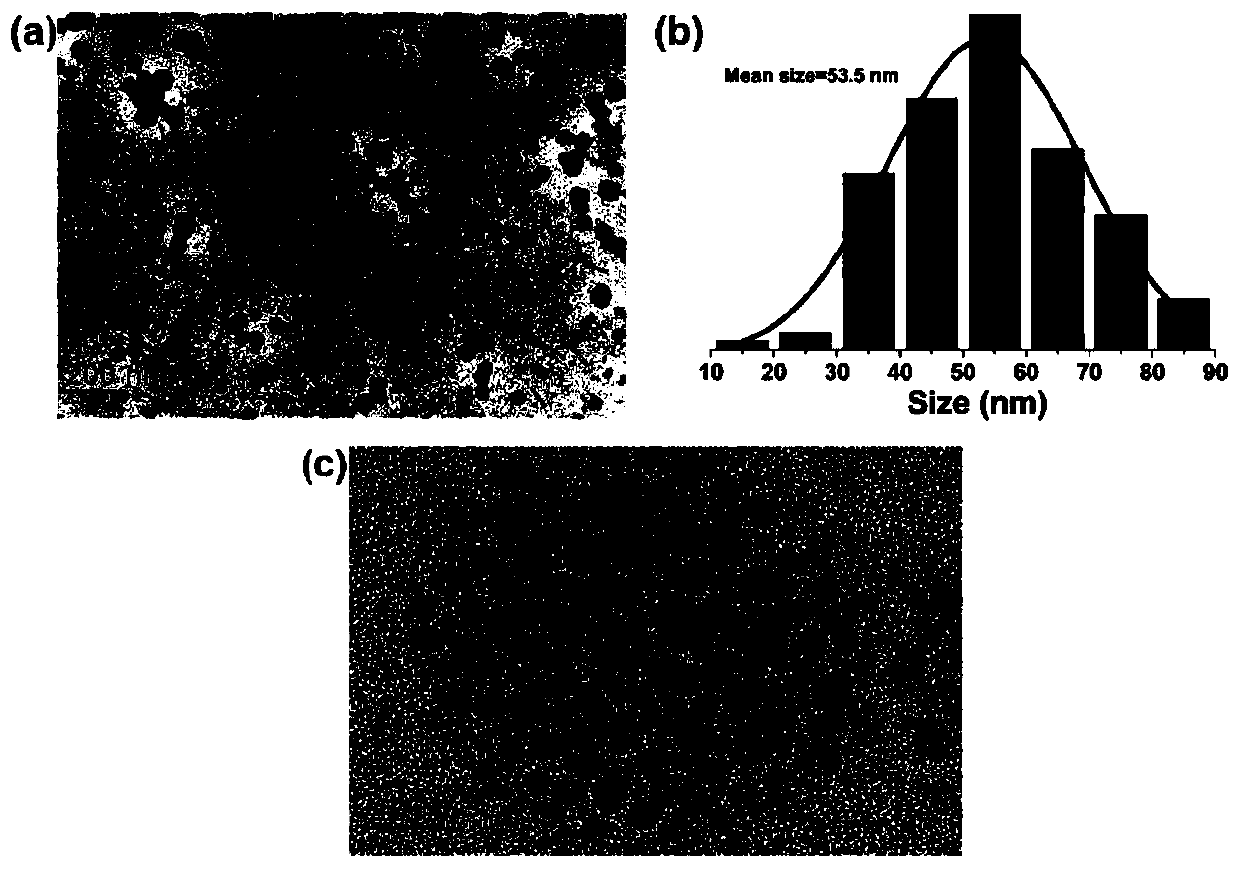A highly sensitive and decomposable quantum dot nanosphere probe and its preparation method
A technology of quantum dots and nanospheres, which is applied in the field of quantum dot nanosphere probes and their preparation, which can solve problems such as limiting the scope of use, inability to decompose and release quantum dot particles, and reducing the detection sensitivity of probes
- Summary
- Abstract
- Description
- Claims
- Application Information
AI Technical Summary
Problems solved by technology
Method used
Image
Examples
Embodiment 1
[0065] Embodiment 1 Quantum dot nanoball probe
[0066] Quantum dot nanoball probes include streptavidin-coupled quantum dots, specific single-stranded DNA, and DNA hairpin probe 1, DNA hairpin probe 2 and DNA hairpin probe 3.
[0067] The specific single-stranded DNA contains 24 bases, and the specific sequence is as follows: 5'-GCACTA(y*)CTCCCT(b*)AACATC(x*)TCAAGC(a*)-3'.
[0068] DNA hairpin probe 1 contains 75 bases, and the specific sequence is as follows: 5'-AGGTTA(z)GCTTGA(a)GATGTT(x)AGGGAG(b)TAGTGC(y)TCCAAT(z*)CACAAC(c* ) GCACTA (y*) CTCCCT (b*) AACATC (x*) AAAAAAAAAAAAAAA-desthiobiotin-3'. Among them, z-a is a single chain, x-b-y and y*-b*-x* form a neck structure, z*-c* is a ring structure, A15 is a spacer arm, and desthiobiotin is a desthiobiotin group.
[0069] DNA hairpin probe 2 contains 75 bases, and the specific sequence is as follows: 5'-GATGTT(x)AGGGAG(b)TAGTGC(y)GTTGTG(c)ATTGGA(z)AACATC(x*)TCAAGC(a* ) TCCAAT (z*) CACAAC (c*) GCACTA (y*) AAAAAAAAAAAAAAA-de...
Embodiment 2
[0075] Embodiment 2 The preparation method of quantum dot nanoball probe
[0076] 1) Preparation of DNA hairpin probe solution: Dissolve the three synthetic desthiobiotin-modified DNA probe dry powders in ultrapure water to prepare 10 μM concentrated solutions, and store them at -20°C; 2 HPO 4 , 500mMNaCl) to dilute the probe concentrate into a 5μM solution; heat the prepared DNA probe solution in a 95°C water bath for 5min, then turn off the water bath heater, and slowly cool down to room temperature, and the DNA probe forming a hairpin structure is stored in 4°C.
[0077]2) Preparation of Y-shaped DNA structure: Mix 10 μL of the three DNA hairpin probes mentioned above, 10 μL of specific single-stranded DNA at a concentration of 5 μM, and 10 μL of phosphate buffer, and react at room temperature for 2 hours to form a Y-shaped structure. DNA structure.
[0078] 3) Preparation of quantum dot nanoball probes: fully mix the Y-shaped DNA structure solution with streptavidin-mod...
Embodiment 3
[0083] Embodiment 3 Rapid ultrasensitive detection method based on nanosphere probe
[0084] 1) Add the magnetic beads labeled with antibody A to the sample solution, and shake at room temperature (18-27°C) for 60 minutes to fully combine the antibody A on the magnetic beads with the target analyte; For immunomagnetic beads;
[0085] 2) Using a magnetic stand to separate the immunomagnetic bead-target analyte complex from the sample matrix, remove the sample matrix, and obtain the immunomagnetic bead-target analyte immune complex;
[0086] 3) Add desthiobiotin-modified specific antibody B to the immunomagnetic bead-target analyte complex obtained in 2), and shake at room temperature (18-27°C) for 60 minutes;
[0087] 4) Using a magnetic stand to separate the immunomagnetic bead-target analyte-antibody B complex from the unbound antibody to obtain the immunomagnetic bead-target analyte-antibody B immune complex;
[0088] 5) Add quantum dot nanoball probes to the immunomagneti...
PUM
| Property | Measurement | Unit |
|---|---|---|
| particle size | aaaaa | aaaaa |
Abstract
Description
Claims
Application Information
 Login to View More
Login to View More - R&D
- Intellectual Property
- Life Sciences
- Materials
- Tech Scout
- Unparalleled Data Quality
- Higher Quality Content
- 60% Fewer Hallucinations
Browse by: Latest US Patents, China's latest patents, Technical Efficacy Thesaurus, Application Domain, Technology Topic, Popular Technical Reports.
© 2025 PatSnap. All rights reserved.Legal|Privacy policy|Modern Slavery Act Transparency Statement|Sitemap|About US| Contact US: help@patsnap.com



